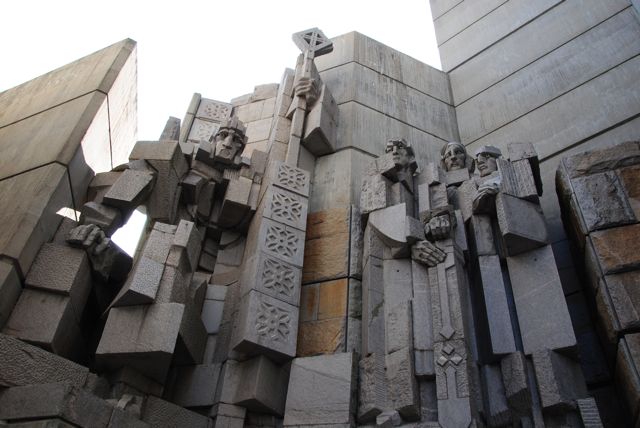
In the middle of this composition, there is the figure of Khan Krum (803-814), who is known as the first Bulgarian leader and legislator. The inscriptions around his figure tell how in 813 he reached the gates of Constantinople and demonstrated his power by performing a ritual sacrifice in front of the confused Byzantines. Looking at his hands, indicating some restriction, Krum says, "From here to here, it is illegal and punishable beyond this." Next to the legislator, one can see in the gallery the figure of Khan Omurtag (814-831), who is better known as a builder and philosopher. He was able to secure for the Bulgarian people a 30-year peace treaty with Byzantium from 815 onwards. Omurtag’s words engraved in the gallery, "Even if a man lives well, he dies and another one comes into existence. Let the one who comes later upon seeing this inscription remembers the one who had made it," even today are reminiscent of the deep philosophical thought of the ruler.
The next figure in the monument is that of Knyaz Boris I, whose importance in terms of history relates to the introduction of Christianity in Bulgaria in 864. Thus, Bulgaria became a member of the "Byzantine family of nations," in which the Bulgarian ruler was considered the spiritual son of the Byzantine Emperor. The figure of Knyaz Boris is bent down, forward looking, as if he is staring into the distance to find the right path for his people.
The figure of Tsar Simeon occupies a central place in the composition of the monument as he turned Bulgaria into one of the greatest European countries during his reign from 893 to 927 and was able to expand the Bulgarian territory to three seas, namely the Black, Aegean and Adriatic Sea. This is one of the reasons for this period of the history of Bulgaria, which is known for its unparalleled economic, cultural and spiritual prosperity, to be called the "Golden Age" of the Bulgarian state. Simeon stood on solid foundations and had a rich heritage. His left hand is raised high, symbolizing the state power and the right one serves as mainstay and his bookmen are on his right hand side not by coincidence. Below him are the boyars, who helped him make important state decisions. The multi-figure composition depicts the faithful and courageous soldiers of Simeon too.
 Against the composition of figures, there is a closing wall, 540 square metres of which are covered with mosaic triptych, the theme of the first panel being "The Winners" - founder Asparukh and his brave soldiers who greet their victory. This is the largest mosaic panel out in the open in Bulgaria. The second panel is dedicated to the Christianization of the Bulgarian people and the adoption of Orthodoxy, and the third presents the educational mission of Cyril and Methodius and their disciples who later formed the basis of Bulgaria’s Golden Age. The mosaic panels contain two identical elements in which the figural composition exists together with fonts. The first panel includes the Proto-Bulgarian runes, the second the Glagolitic alphabet and the third the Cyrillic alphabet. The letters are seen as a sign of civilization and therefore the conversion can be interpreted as a cultural and political, not as a religious, act.
Against the composition of figures, there is a closing wall, 540 square metres of which are covered with mosaic triptych, the theme of the first panel being "The Winners" - founder Asparukh and his brave soldiers who greet their victory. This is the largest mosaic panel out in the open in Bulgaria. The second panel is dedicated to the Christianization of the Bulgarian people and the adoption of Orthodoxy, and the third presents the educational mission of Cyril and Methodius and their disciples who later formed the basis of Bulgaria’s Golden Age. The mosaic panels contain two identical elements in which the figural composition exists together with fonts. The first panel includes the Proto-Bulgarian runes, the second the Glagolitic alphabet and the third the Cyrillic alphabet. The letters are seen as a sign of civilization and therefore the conversion can be interpreted as a cultural and political, not as a religious, act.
Today the monument is guarded and maintained by the municipality of Shumen and is open to visitors at any time. Those who want to know more about the history of the monument to the "Founders of the Bulgarian State" and to understand the meaning of its figures, have to pay a small fee at the entrance, but otherwise the space is free to visit. It can be approached from the 1,300 stairs from the city of Shumen, which symbolize each year of the establishment of the Bulgarian state.